Who knows what evil lurks in the hearts of invisible men? Maybe not the Shadow – but animation fans certainly do! For part one of this survey, click here. For the rest of the examination, read on!
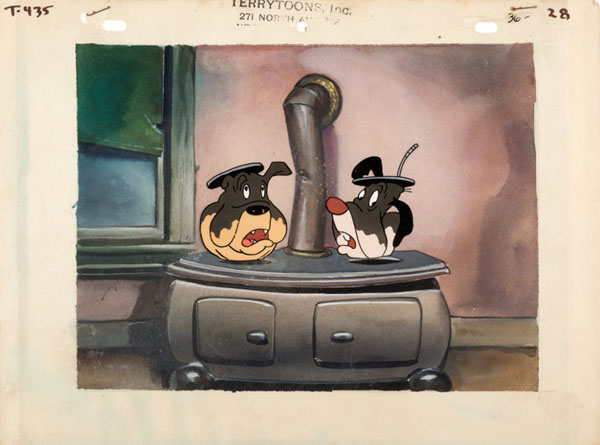
The Hitch Hikers (Terrytoons/Fox, Heckle and Jeckle, 12.12.47 – Connie Rasinski, dir.) – In a plot a bit more clever than usual for the magpies, our troublesome twins try their hand at thumbing for a ride down the highway -with little luck. Spotting a roadside diner, they see a car waiting in front, with Dimwit as the driver. “How about a lift”, they ask. Before Dimwit can say “Duh”, they’re already accepting his “invitation” and seated inside. “I don’t think my friend is going to like this”, Dimwit finally gently protests. The magpies insist they’ll handle this “friend” – but get more than they bargained for, as the friend turns out to be the usual tough bulldog, today in the role of a holdup man, who guns his way out of the restaurant carrying a sack of money. As he tells Dimwit to step on it, he is surprised to find the magpies inside right behind the loot. Jeckle stammers, “This is where we get off, old boy”, but the bulldog insists they’re not going anywhere, as they know too much. Heckle, however, cleverly yanks on the emergency brake, bringing the speeding car to a sudden stop – and sending the two bandits crashing through the windshield, as H&J wave them bye-bye. The crooks are briefly knocked out of action, crashing into respective trees.
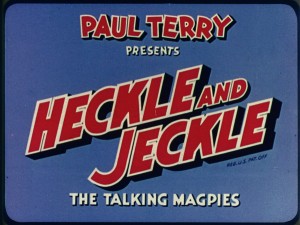 Hours later, H&J, proceeding on foot ahead, complain that they can’t walk another step. One of them spots a dilapidated cabin, and the door is ajar. They enter, happy for the shelter, as Heckle observes, “This looks like a good hide-out.” How right he is – it’s the crooks’ hideout! Their car pulls up, and the magpies hide under a table. The crooks enter, the bulldog still ruffled over the afternoon’s events. “If I ever get my hands of those two boids, I’ll tear ‘em apart. I’ll punch ‘em to pieces. I’ll bet ‘em to a pulp!” All the while he demonstrates on Dimwit, whose eyes roll as he responds, “That’ll fix ‘em, boss!” The money bag is left on the table, and the magpies pull it under the tablecloth. When the money is discovered to be missing, the dogs eventually lift up the table – to find the magpies dividing the money amongst themselves (a bit of a derivation from the money-counting gag in Bugs Bunny’s Racketeer Rabbit). The chase is on, and the magpies retreat into a small room. The bulldog shoots some holes in the door – but Heckle pops his head and hands out the holes and sticks his tongue out at the bulldog. (A sequence cut for time at this point in the cartoon in current CBS prints involved what CBS probably considered a dated satire on then-current radio show, “The $64 Question”, with Heckle delivering double-talk questions to the bulldog and Dimwit using the catch-phrase of the show, “You’ll be sorry!” – with the bulldog ultimately winning a consolation prize of a custard pie – right in the face (a scene still ending the network opening montage for the Heckle and Jeckle Show).) Inside the room, the birds have found a container of vanishing cream. They apply same to themselves liberally, while keeping up a mocking chatter to the dogs. “Oh, he got us, old pal”. “Yeah, he rubbed us out.” The birds bid each other verbal goodbyes, open the door, and collapse backwards out the door onto the floor – then, to the dogs’ shock, disappear!
Hours later, H&J, proceeding on foot ahead, complain that they can’t walk another step. One of them spots a dilapidated cabin, and the door is ajar. They enter, happy for the shelter, as Heckle observes, “This looks like a good hide-out.” How right he is – it’s the crooks’ hideout! Their car pulls up, and the magpies hide under a table. The crooks enter, the bulldog still ruffled over the afternoon’s events. “If I ever get my hands of those two boids, I’ll tear ‘em apart. I’ll punch ‘em to pieces. I’ll bet ‘em to a pulp!” All the while he demonstrates on Dimwit, whose eyes roll as he responds, “That’ll fix ‘em, boss!” The money bag is left on the table, and the magpies pull it under the tablecloth. When the money is discovered to be missing, the dogs eventually lift up the table – to find the magpies dividing the money amongst themselves (a bit of a derivation from the money-counting gag in Bugs Bunny’s Racketeer Rabbit). The chase is on, and the magpies retreat into a small room. The bulldog shoots some holes in the door – but Heckle pops his head and hands out the holes and sticks his tongue out at the bulldog. (A sequence cut for time at this point in the cartoon in current CBS prints involved what CBS probably considered a dated satire on then-current radio show, “The $64 Question”, with Heckle delivering double-talk questions to the bulldog and Dimwit using the catch-phrase of the show, “You’ll be sorry!” – with the bulldog ultimately winning a consolation prize of a custard pie – right in the face (a scene still ending the network opening montage for the Heckle and Jeckle Show).) Inside the room, the birds have found a container of vanishing cream. They apply same to themselves liberally, while keeping up a mocking chatter to the dogs. “Oh, he got us, old pal”. “Yeah, he rubbed us out.” The birds bid each other verbal goodbyes, open the door, and collapse backwards out the door onto the floor – then, to the dogs’ shock, disappear!
The bulldog and Dimwit retreat back to the living room table but not before we see the magpies reappear in the room ahead of them. Heckle lingers under the tablecloth, changing his voice to sound like one of those old omniscient radio narrators such as “The Whistler”. With a menacing laugh, he states, “So, you think you are rid of them, eh? Well, maybe no mortal eye can see them, but they’re here!” In similar inexplicable fashion to the studio’s earlier “Bugs Beetle and His Orchestra” (see last week’s article), H&J manage to turn their invisibility on and off at will, appearing from nowhere to write “Exit” on a door – which in reality only holds an ironing board to clobber the bulldog. A rubber glove is inflated by Jeckle and coated with catsup, appearing to be a floating bloody hand – which becomes even more menacing when it flies around the room upon being deflated by a pistol shot. The birds magically reappear again behind Dimwit and knock him out with a tiny hammer, placing him on his back on a rolling table and covering him with a sheet, so that the bulldog thinks he is a floating corpse. (Parts of this chase footage are also removed from the current CBS abridgement – but can still be seen in the montage of footage from the TV show’s opening, just before the custard pie.) Finally, the dogs plummet down a staircase, Dimwit landing with the sheet still over him, frightening away the bulldog through the glass window as Dimwit races closely behind him. Later, H&J are roasting wieners at the cabin fireplace, as Heckle comments at how dumb those dogs were to fall for their corny ghost gags. To their shock, a real ghost materializes over Heckle, saying, “Yes. Can you imagine?”, sending our terrified duo out the window themselves and heading for the hills.
Daffy Duck Slept Here (Warner, Porky Pig/Daffy Duck, 3/6/48 – Robert McKimson, dir.), presents invisibility of an unusual kind – likely animation’s first “imaginary friend”. Satirizing the stage hit and eventual James Stewart movie vehicle “Harvey”, about a mild-mannered adult man and his imaginary friend – a six-foot tall invisible rabbit, – Porky endures the entrance, into the hotel room he must share for the night during a convention, of his roommate Daffy Duck, and Daffy’s bar-buddy with whom he’s been “making the rounds” – a six foot tall invisible kangaroo named “Hymie”. After Daffy sings a chorus of “I’m Just Wild About Hymie” (change of lyric to the song “I’m Just Wild About Harry”) and shouts Hymie’s praises like a college cheerleader, Porky announces that he doesn’t believe there’s an invisible kangaroo in the room. “Oh no?”, replies Daffy. He reaches to the air alongside himself as if unzipping a zipper positioned sideways, then jumps into the airspace, his torso disappearing from view so that we see him suspended in mid-air only from the shoulders up. As if being carried in an unseen pouch, Daffy begins bouncing around the room. “Then how do you think I’m doing this?”. shouts Daffy.
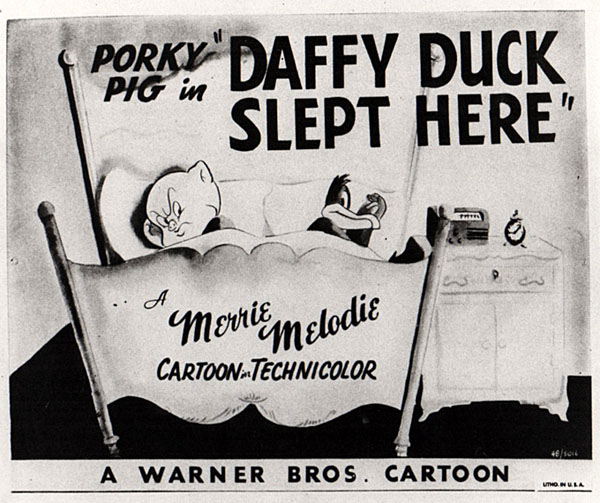
The Leghorn Blows At Midnight (Warner, Foghorn Leghorn/Henery Hawk. 5/6/50 – Robert McKimson, dir.) – The film’s title is a play-on words upon Jack Benny’s often self-lampooned feature fantasy for Warner’s, The Horn Blows At Midnight, although the cartoon’s subject matter has nothing to do with angelic trumpet playing. Instead, Foghorn is again warding off his own capture by talking Henery into thinking Barnyard Dawg should be his intended prey – a pheasant! Foghorn plays a sneaky trick on Henery, in the only cartoon of its kind to play upon the real-life fact that a standard convention of cartoon invisibility doesn’t work! Foghorn “helps” Henery by applying a liberal coat of vanishing cream upon Henery’s person, then pretends he can’t see him – knowing all the time that Henery is still fully visible. With new confidence at his cloaked identity, Henery enters the doghouse. Letting out with a villainous laugh, he confronts the Dawg – “I gotcha now. I’m the invisible hawk. You can’t see me. I might be twenty feet tall. You can’t fight what ya’ can’t see.” The Dawg, absolutely unimpressed by these baseless threats, pulls out a small pocket mirror, and places it in front of Henery. Henery continues his rant: “I got ‘cha now, you nincum – – -“, then sees his reflection: “- – -Poop!” Exit our would-be invisible man.

Destination Meatball (Lantz/Universal, Woody Woodpecker, 12/24/51 -Walter Lantz, dir.) – The title of this episode returns a favor, as George Pal had given Lantz a break during a financial crisis by commissioning a full-length Woody Woodpecker segment for the Pal feature for Eagle-Lion Pictures, “Destination Moon” in 1950. That segment was the proving ground for Lantz’s newly-regrouping staff of animators, and the first appearance of Lantz’s wife Grace Stafford as the voice of Woody. Of course, when Castle Films released this title to home movies, they thought it best to rechristen its name to something more saleable – “Invisible Woody”.
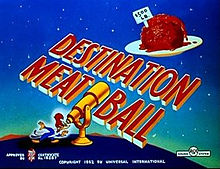 The cartoon has nothing to do with the space race, but instead examines the then-new convention of the super-duper supermarket (with a trough at the windows for customers to drool, and jacks under the price tags to “jack up” the prices). A filthy-rich pig enters with a wheelbarrow of money – and comes out wearing a barrel, with only a single small chop of meat. Buzz Buzzard runs the whole underhanded operation, and has no tolerance for freeloaders like Woody, who’d rather use the place as a convenient lunch counter. Buzz tries to hit Woody with an exorbitant bill, including a large overcharge reading “Hidden Tax” – which he makes sure stays hidden by covering the line with invisible ink before handing the register slip to Woody. Of course, our hero has only five cents in his own miniature cash register strapped to his waist, the register reading “No Sale”. A scuffle with Buzz knocks the woodpecker into a counter, where the invisible ink bottle is knocked over, some of it spilling on Woody. In a deliberately gruesome scene, the ink makes most of Woody’s torso disappear, leaving him appearing as a dismembered head, arms and legs. Buzz finds Woody this way, knocked out cold, and envisions himself modeling a hangman’s noose. He grabs a broom and sweeps the “body parts” into a cellar trap door (the animation deliberately distorted with limbs in positions that they could never possibly achieve if still connected to a torso – likely accounting for the absence of this title from most if not all Woody TV packagings.) Woody awakens in the cellar, sees his reflection in a mirror, and eventually catches on, obtaining more ink to vanish completely (a good gag has his head not immediately disappear entirely, but reveal inside his skull that his brain is full of metal “nuts”.)
The cartoon has nothing to do with the space race, but instead examines the then-new convention of the super-duper supermarket (with a trough at the windows for customers to drool, and jacks under the price tags to “jack up” the prices). A filthy-rich pig enters with a wheelbarrow of money – and comes out wearing a barrel, with only a single small chop of meat. Buzz Buzzard runs the whole underhanded operation, and has no tolerance for freeloaders like Woody, who’d rather use the place as a convenient lunch counter. Buzz tries to hit Woody with an exorbitant bill, including a large overcharge reading “Hidden Tax” – which he makes sure stays hidden by covering the line with invisible ink before handing the register slip to Woody. Of course, our hero has only five cents in his own miniature cash register strapped to his waist, the register reading “No Sale”. A scuffle with Buzz knocks the woodpecker into a counter, where the invisible ink bottle is knocked over, some of it spilling on Woody. In a deliberately gruesome scene, the ink makes most of Woody’s torso disappear, leaving him appearing as a dismembered head, arms and legs. Buzz finds Woody this way, knocked out cold, and envisions himself modeling a hangman’s noose. He grabs a broom and sweeps the “body parts” into a cellar trap door (the animation deliberately distorted with limbs in positions that they could never possibly achieve if still connected to a torso – likely accounting for the absence of this title from most if not all Woody TV packagings.) Woody awakens in the cellar, sees his reflection in a mirror, and eventually catches on, obtaining more ink to vanish completely (a good gag has his head not immediately disappear entirely, but reveal inside his skull that his brain is full of metal “nuts”.)
Seeing Buzz doing more price-increasing skullduggery (pumping hot dogs with air, adding weights made invisible on top of packaged steaks, etc.), Woody tries to teach him a lesson by engaging in a little spooking. A creative idea has him use a large white tarp, some poles, and the flat side of two cut hams as huge “eyes”, to create a giant ghost replica of himself to scare Buzz. But Woody’s ink wears off, exposing his feet under the tarp, and Buzz discovers he’s still alive. Woody heads for the ink bottle and acquires another dose just in time to miss Buzz’s grasp. Buzz grabs a meat cleaver, and follows invisible Woody through a spinning turnstile, despite Woody’s efforts to ward off Buzz with a barrage of bananas. Finally, the door to the meat freezer invisibly opens. Buzz’s cleaver follows inside – but the door slams shut behind him, as Woody didn’t go in. After a few seconds, a light goes on over the door. The door is opened, and an ice-statue version of Buzz is pushed out from the freezer. The last shot shows supermarket cart after cart of groceries being wheeled out the market door, the last cart being pushed invisibly, but with Woody fading back into view in time for his signature laugh and the fade out.
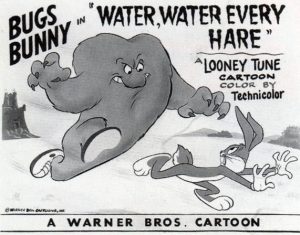 Water, Water, Every Hare (Warner, Bugs Bunny, 4/19/52 – Charles M. (Chuck) Jones, dir.). marks Bugs’ second encounter with the giant red hairy monster with tennis shoes, who eventually was named “Gossamer” for “Duck Dodgers and the Return of the 24 1/2th Century”. Again, the encounter takes place in a mad scientist’s laboratory (though the first owner of Gossamer was Peter Lorre – now he’s changed hands to an animated counterpart to Vincent Price). As bugs flees from the giant redhead into the doctor’s lab, he spies two bottles on a shelf – one marked “Reducing Oil”, and the other “Vanishing Fluid”. Bugs pours the contents of the second bottle upon himself, and disappears. As Gossamer creeps into the room, an invisible Bugs slams down a metal trash can over Gossamer’s head, then pounds the can with a large mallet, vibrating the monster wildly. He pulls a rug from under Gossamer’s feet, flipping him to the ground. Then he applies the reducing oil – and Gossamer is shrunken to the size of a mouse, his roar diminishing into an “Eep.” Gossamer disappears briefly out of scene, then reappears in a miniature hat, vest, and carrying two small suitcases. He goes into a mousehole in the wall, kicking the resident mouse out, and slams a door on the mousehole, on which he has posted a sign reading, “I quit”. The befuddled mouse pulls out from nowhere a small bottle marked “XXX”, and declares to the audience, “I quit too!” Bugs’ invisibility, is, however, brought to an abrupt halt, as another fluid is poured upon him from above, returning him to view. Above stands the professor, with a now empty bottle of “Hare Restorer”. “Never send a monster to do the work of an evil scientist”, concludes the doctor.
Water, Water, Every Hare (Warner, Bugs Bunny, 4/19/52 – Charles M. (Chuck) Jones, dir.). marks Bugs’ second encounter with the giant red hairy monster with tennis shoes, who eventually was named “Gossamer” for “Duck Dodgers and the Return of the 24 1/2th Century”. Again, the encounter takes place in a mad scientist’s laboratory (though the first owner of Gossamer was Peter Lorre – now he’s changed hands to an animated counterpart to Vincent Price). As bugs flees from the giant redhead into the doctor’s lab, he spies two bottles on a shelf – one marked “Reducing Oil”, and the other “Vanishing Fluid”. Bugs pours the contents of the second bottle upon himself, and disappears. As Gossamer creeps into the room, an invisible Bugs slams down a metal trash can over Gossamer’s head, then pounds the can with a large mallet, vibrating the monster wildly. He pulls a rug from under Gossamer’s feet, flipping him to the ground. Then he applies the reducing oil – and Gossamer is shrunken to the size of a mouse, his roar diminishing into an “Eep.” Gossamer disappears briefly out of scene, then reappears in a miniature hat, vest, and carrying two small suitcases. He goes into a mousehole in the wall, kicking the resident mouse out, and slams a door on the mousehole, on which he has posted a sign reading, “I quit”. The befuddled mouse pulls out from nowhere a small bottle marked “XXX”, and declares to the audience, “I quit too!” Bugs’ invisibility, is, however, brought to an abrupt halt, as another fluid is poured upon him from above, returning him to view. Above stands the professor, with a now empty bottle of “Hare Restorer”. “Never send a monster to do the work of an evil scientist”, concludes the doctor.
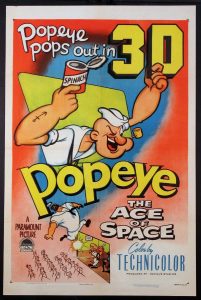 Popeye, the Ace of Space (Paramount/Famous, Popeye, 10/2/53 – Seymour Knietel, dir.), reworks some of the same gags from the earlier “Rocket To Mars”, discussed last week. This time, instead of a runaway rocket, Popeye is abducted by means of aliens dropping an outer-space version of a plunger upon his head, the handle of which develops propeller blades and flies him like a helicopter into the hold of the invading saucer. Back on Mars, a group of green Martian heavies perform a series of tests on Popeye to determine the vulnerability of Earth men to attack. After a Cosmic Ager and Atom Apple Smasher fail to have the desired effect due to Popeye’s spinach, the Martians try a disintegrator ray. Its beam has the same effect as the light ray in the 1940’s version – appearing to disintegrate Popeye (who first attempts to light his pipe with it, only to have his hand disappear), but in fact only turning him invisible – which is revealed when his fallen spinach can rolls back to him after the Martians lose it in a fist fight over it as the mysterious source of the Earthman’s power. In a much more simplified finish than the elaborate amusement-park ending to the 1940’s version, Popeye makes the Martians peaceable (after downing his spinach and becoming visible again) by socking them into their own scientific equipment, which is converted by the impact into a giant Maypole around which the Martians dance effeminately. This was the studio’s first venture into 3-D animation (billed as a “Stereotoon”) during the 1953 craze for such special processes, and in fact (having had the opportunity to see the film in 35mm at a 3-D festival at the Egyptian Theater in Hollywood) was among the most effective uses of the process in the animation field – well beating out efforts by both Disney and Warner Brothers in the same medium for convincing depth and in-your-face effects. Popeye thus appropriately ends his closing saucer flight back to earth with two toots of smoke from his pipe that float toward the camera and transform into the lettering “A Paramount Picture” for the reappearance of the studio’s mountain logo and the fade out.
Popeye, the Ace of Space (Paramount/Famous, Popeye, 10/2/53 – Seymour Knietel, dir.), reworks some of the same gags from the earlier “Rocket To Mars”, discussed last week. This time, instead of a runaway rocket, Popeye is abducted by means of aliens dropping an outer-space version of a plunger upon his head, the handle of which develops propeller blades and flies him like a helicopter into the hold of the invading saucer. Back on Mars, a group of green Martian heavies perform a series of tests on Popeye to determine the vulnerability of Earth men to attack. After a Cosmic Ager and Atom Apple Smasher fail to have the desired effect due to Popeye’s spinach, the Martians try a disintegrator ray. Its beam has the same effect as the light ray in the 1940’s version – appearing to disintegrate Popeye (who first attempts to light his pipe with it, only to have his hand disappear), but in fact only turning him invisible – which is revealed when his fallen spinach can rolls back to him after the Martians lose it in a fist fight over it as the mysterious source of the Earthman’s power. In a much more simplified finish than the elaborate amusement-park ending to the 1940’s version, Popeye makes the Martians peaceable (after downing his spinach and becoming visible again) by socking them into their own scientific equipment, which is converted by the impact into a giant Maypole around which the Martians dance effeminately. This was the studio’s first venture into 3-D animation (billed as a “Stereotoon”) during the 1953 craze for such special processes, and in fact (having had the opportunity to see the film in 35mm at a 3-D festival at the Egyptian Theater in Hollywood) was among the most effective uses of the process in the animation field – well beating out efforts by both Disney and Warner Brothers in the same medium for convincing depth and in-your-face effects. Popeye thus appropriately ends his closing saucer flight back to earth with two toots of smoke from his pipe that float toward the camera and transform into the lettering “A Paramount Picture” for the reappearance of the studio’s mountain logo and the fade out.
The Vanishing Duck (MGM, Tom & Jerry, 5/2/58 – William Hanna/Joseph Barbera, dir.) – The center of attention for the day is Little Quacker, who has just been given as a birthday present to the lady of the house, trained to sing “Good Morning To You” whenever his box is opened. Hubby also takes the Missus out to dinner, leaving the house an unguarded target for Tom. Tom of course opens the surprise box, confusing Quacker into delivering a verse of “Good Morning, dear Pussy Cat”. Quacker wises up quickly when Tom swallows him, and Quacker has to make an escape by opening one of Tom’s eyes from inside like a window. Quacker beats a retreat into Jerry’s mousehole, but when he tries to show Jerry the “big pussy cat”, Tom pounces on Quacker. Jerry trips Tom with an electric cord, and Quacker flies out of Tom’s grasp – landing waist deep in a jar of vanishing cream. Noticing his invisible lower half, Quacker applies the goop everywhere, and vanishes. He reciprocates for Jerry’s rescue by approaching Tom with a seemingly floating hammer, and using it to smash Tom’s big toe. Grabbing Jerry’s hand, Quacker drags him to the cream bottle, and lets Jerry in on the secret. They both apply the substance and vanish. Tom is still puzzling over the hammer, which he can’t get to move on its own. He shrugs it off, and takes a break, going to the refrigerator for a slice of watermelon. The kitchen door opens mysteriously, then two invisible somethings climb the slats of the Venetian blinds. Suddenly, two bites disappear out of Tom’s melon, and Tom is hit in the face by two streams of spit watermelon seeds. Tom runs to the bathroom mirror, examining his own eyes and tongue to figure out whether he’s sick.
 But an invisible hand grabs the end of his tongue and stretches it out – while a second invisible creature dumps the whole contents of an aspirin bottle on his tongue – then, they let his tongue go, snapping all the pills into his throat to be swallowed. (Oddly, I never remember any local stations cutting this shot – really, should we show this one to the kids?) Tom runs, hiding around a corner with his back facing an open closet door. The invisible duo play another sadistic trick. They slam the closet door, catching Tom’s tail painfully in it. Inside the closet, they take more of the vanishing cream and coat all but the stump of Tom’s tail with it. Then, they cut a surprisingly similar tail off a fur stole the Missus keeps in the closet. When Tom gets the closet door open, his tail (now invisible) appears to have been cut off – while the furpiece tail goes running under its own power out of the closet and across the room, disappearing into Quacker’s box. Tom lifts the box lid, and his “tail” (in Quacker’s voice) dances another chorus of “Good Morning To You” at him, then goes limp. Tom next spots the bulges of two “somethings” moving under the living room rug. He grabs a fireplace shovel and waits to smash whatever-they-are when they reach the edge of the rug – but nothing visible comes out from underneath, causing Tom’s eyes to pop. The coal shovel, and a sort of pincers coal-grabber, now come to life, the shovel smacking Tom in the rear, then both objects pursuing Tom to the front door, where the pincers pick up Tom by the remaining visible stump of his tail, and the shovel knocks Tom out the front door through the mail slot. The two objects trot happily back into the house, and a few moments later we see Jerry and Quacker rubbing off the cream with handkerchiefs. In a rather forced and notably unnatural exchange of dialogue, Quacker repeats to Jerry what both he and the audience already know: “It was the vanishing cream that did it.” Tom, looking in the window, does a take and catches on. Slipping in the window, he applies the cream to himself. Moments later, the coal shovel is observed floating again – this time behind Jerry and Quacker. It comes down upon them with a splat. “I-i-is that you, Mr. Pussy cat?, asks Quacker. The answer is another pounding smack. Quacker and Jerry race for their lives, as the shovel continues to pursue them through the corridors, landing blow after blow upon them along the way.
But an invisible hand grabs the end of his tongue and stretches it out – while a second invisible creature dumps the whole contents of an aspirin bottle on his tongue – then, they let his tongue go, snapping all the pills into his throat to be swallowed. (Oddly, I never remember any local stations cutting this shot – really, should we show this one to the kids?) Tom runs, hiding around a corner with his back facing an open closet door. The invisible duo play another sadistic trick. They slam the closet door, catching Tom’s tail painfully in it. Inside the closet, they take more of the vanishing cream and coat all but the stump of Tom’s tail with it. Then, they cut a surprisingly similar tail off a fur stole the Missus keeps in the closet. When Tom gets the closet door open, his tail (now invisible) appears to have been cut off – while the furpiece tail goes running under its own power out of the closet and across the room, disappearing into Quacker’s box. Tom lifts the box lid, and his “tail” (in Quacker’s voice) dances another chorus of “Good Morning To You” at him, then goes limp. Tom next spots the bulges of two “somethings” moving under the living room rug. He grabs a fireplace shovel and waits to smash whatever-they-are when they reach the edge of the rug – but nothing visible comes out from underneath, causing Tom’s eyes to pop. The coal shovel, and a sort of pincers coal-grabber, now come to life, the shovel smacking Tom in the rear, then both objects pursuing Tom to the front door, where the pincers pick up Tom by the remaining visible stump of his tail, and the shovel knocks Tom out the front door through the mail slot. The two objects trot happily back into the house, and a few moments later we see Jerry and Quacker rubbing off the cream with handkerchiefs. In a rather forced and notably unnatural exchange of dialogue, Quacker repeats to Jerry what both he and the audience already know: “It was the vanishing cream that did it.” Tom, looking in the window, does a take and catches on. Slipping in the window, he applies the cream to himself. Moments later, the coal shovel is observed floating again – this time behind Jerry and Quacker. It comes down upon them with a splat. “I-i-is that you, Mr. Pussy cat?, asks Quacker. The answer is another pounding smack. Quacker and Jerry race for their lives, as the shovel continues to pursue them through the corridors, landing blow after blow upon them along the way.
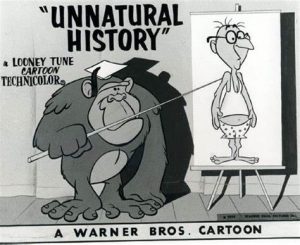 Unnatural History (Warner, 11/14/59 – Abe Levitow, dir.) – a spot-gag reel on nature studies (previously discussed for its brief coverage of ants in my Bugz’ Livez: Antz (pt. 3) article), features a bit on nature’s “invisible man” and camouflage expert – the chameleon. One of such critters shows off his talent by leaping before various cards of different colors, instantly blending into the color of each card behind him. But as he makes his final leap, he screeches to a braking stop in mid-air, avoiding coming before the last card, which is printed in a Scottish kilt-style plaid. The chameleon breaks into a crying tantrum on the floor, shouting, “I cant do it. I CAN’T do it!”
Unnatural History (Warner, 11/14/59 – Abe Levitow, dir.) – a spot-gag reel on nature studies (previously discussed for its brief coverage of ants in my Bugz’ Livez: Antz (pt. 3) article), features a bit on nature’s “invisible man” and camouflage expert – the chameleon. One of such critters shows off his talent by leaping before various cards of different colors, instantly blending into the color of each card behind him. But as he makes his final leap, he screeches to a braking stop in mid-air, avoiding coming before the last card, which is printed in a Scottish kilt-style plaid. The chameleon breaks into a crying tantrum on the floor, shouting, “I cant do it. I CAN’T do it!”
House of Hashimoto (Terrytoons, Hashimoto-San, 11/30/60 – Connie Rasinski, dir.), provides a late return of the Terry studio to the field of invisibility. Hashimoto’s friend G.I. Joe (a mouse, not the Hasbro soldier), is a reporter looking for some local color story of interest. Hashimoto tells him what he represents as a true story – about a mouse born invisible at birth. While no scientific explanation is discovered, village folks eventually get used to the unusual newcomer, and he grows to maturity, becoming a skilled swordsman and archer. The village, however, is periodically ravaged by a giant cat from another valley. On one of the cat’s raids, while the villagers hide in a cave, the invisible mouse, wearing battle garments, challenges the cat to a duel. The cat attempts to crush him – but finds only a pile of the mouse’s clothing following the blow. The mouse’s sword, invisibly held, creeps up behind the cat, and lets him have it, striking both feet and his rear end. A rope appears, and guided by an invisible hand, wraps itself around the cat to tie him up. Then, more ropes seize the cat’s feet, and are secured at their other ends to two sapling trees, which lift the cat into the air flipped upside down. The invisible mouse pulls on the cat and stretches the trees to fashion a sort of giant slingshot – and “cat-apults” the cat over the farthest mountain, never to be heard from again. What later became of the invisible mouse? A blow to the head in a dueling practice mysteriously causes him to become visible – normal in all respects, except that once a month in the light of a full moon, he becomes invisible again until dawn. Joe has followed this tale until hearing the ending, and suspends his belief, saying, “Hashimoto! I can’t print that. They’d laugh at me.” Thanking Hashimoto anyway, Joe departs. As Hashimoto says parting words to the audience, a cloud above drifts with the breeze, exposing a full moon. The invisible mouse turns out to be Hashimoto himself! He leaves us with the words, “Wise old philosopher once say, He who is not seen, is real gone, man”, and his traditional “Sayonara.”
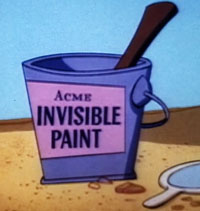 Wile E. Coyote made use of invisible paint at least twice. In War and Pieces (Warner, Road Runner, 6/6/64 – Chuck Jones/Maurice Noble, dir.), he applies the substance to himself, admires his invisible handiwork in a mirror, and then (in a path only identified by his footprints), waits behind a cliff face near the side of the road. Hearing an approaching beep, his footprints leap out into the road – only to get plowed down by a passing truck. His footprints are now on the move again, but stumbling every which way, and then leading off a cliff. Below, a coyote silhouette is punctured into a row of low-lying clouds, and a splash is seen in a canyon river. The paint’s not waterproof like Donald Duck’s, and the coyote is revealed in an underwater shot, upside down with his head buried in the river bottom. A passing fish observes with curiosity, until Wile E.’s hand holds up a sign to him, reading, “Get Lost!”
Wile E. Coyote made use of invisible paint at least twice. In War and Pieces (Warner, Road Runner, 6/6/64 – Chuck Jones/Maurice Noble, dir.), he applies the substance to himself, admires his invisible handiwork in a mirror, and then (in a path only identified by his footprints), waits behind a cliff face near the side of the road. Hearing an approaching beep, his footprints leap out into the road – only to get plowed down by a passing truck. His footprints are now on the move again, but stumbling every which way, and then leading off a cliff. Below, a coyote silhouette is punctured into a row of low-lying clouds, and a splash is seen in a canyon river. The paint’s not waterproof like Donald Duck’s, and the coyote is revealed in an underwater shot, upside down with his head buried in the river bottom. A passing fish observes with curiosity, until Wile E.’s hand holds up a sign to him, reading, “Get Lost!”
Much less creatively, DePatie-Freling’s loan-out effort for Warner, Clippity Clobbered (3/12/66 – Rudy Larriva, dir.) has Wile E. mix a new batch of the paint with a mail-order chemistry set. In a totally different (and somewhat ineffective) style of depicting invisibility, perhaps borrowed in concept from Harvey Casper comic books, anything painted is shown in transparency with dotted line character or object outlines. Wile E. first paints himself again, and waits in the road at a curve along a cliff edge. The Road Runner, not seeing him, bumps right into him, and knocks him over the cliff. Landing in the canyon below, the coyote turns visible. Breaking a cardinal rule of Chuck Jones’s “gospel” on the character, the animators have the Road Runner retaliate, by finding the paint can and using it to paint a boulder, then pushing the invisible rock off the cliff too to smash down on the coyote. A second and even worse sequence has Wile E. build a brick wall across the road, then paint it invisible. Despite maintaining the dotted outlines of the wall to establish that it’s really there, the Road Runner defies the animator’s drawing by running right through the wall as if nothing’s there. Of course, when the coyote tries the same, he crashes into it. With the bad planning and execution of this gag, it’s just not funny!
As made-for-TV animation took prominence over theatrical productions, invisibility would become an often returned-to trope for various producers – but perhaps no one more than footage-mill Hanna-Barbera. While an exhaustive list of invisibility TV cartoons is probably beyond the reach of this article, following are a few highlights:
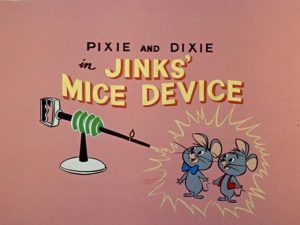 Jinks’ Mice Device, a Pixie and Dixie cartoon from the “Huckleberry Hound” show, is perhaps the closes descendent of H-B’s theatrical days – liberally inspired by and a homage to Tom & Jerry’s The Vanishing Duck. (And why not, with MGM veterans like Kenneth Muse, Michael Lah, Montealegre and Dan Gordon on the credits?) Jinks is working secretly in the basement on his masterpiece of inventiveness – a space-age style ray gun – the “Zero Ray Mice Device” – guaranteed to “discombooberate” the “meeces” and leave – what else? – zero. Talking the mice into thinking the invention is a camera, Jinks has the mice smile pretty while he lines them up in his sights, and pulls the trigger. True to his promise, the mice fade and vanish entirely. Jinks dreams of the millions he’ll make, and proceeds to the telephone, where he commences an order for a new yacht in baby blue to match his eyes. But Jinks must have gotten his design ideas from those aliens who couldn’t obliterate Popeye, because his ray has in actuality had the identical effect – the mice are merely invisible. The mice decide to use their new power to full advantage. Jinks’ phone call is interrupted by the intrusion of a floating hammer (a direct lift from Vanishing Duck) and a pair of pliers. The pliers grab the toes of one of the cat’s feet, while the hammer smashes the other one. While Jinks moans in double pain, the tools exit, followed by the entry of a floating axe and saw. “Oh no, not again!” says Jinks, and ducks for cover behind the sofa. The mice are not entirely cruel, and exit with their tools without following up on the feigned attack. Jinks is convinced he’s having hallucinations, and when he finds nothing after peeping out from behind the sofa, decides, “Next time, I will just ignore it.” Out from behind a curtain rolls a lawn mower. Jinks follows his own advice and pretends it doesn’t exist – and gets knocked to the ground, with the fur scalped from his entire backside. “Gee, I reckon I hadn’t oughta ignore that thing again”, concludes Jinks – but too late, as the mower makes a second pass over him.
Jinks’ Mice Device, a Pixie and Dixie cartoon from the “Huckleberry Hound” show, is perhaps the closes descendent of H-B’s theatrical days – liberally inspired by and a homage to Tom & Jerry’s The Vanishing Duck. (And why not, with MGM veterans like Kenneth Muse, Michael Lah, Montealegre and Dan Gordon on the credits?) Jinks is working secretly in the basement on his masterpiece of inventiveness – a space-age style ray gun – the “Zero Ray Mice Device” – guaranteed to “discombooberate” the “meeces” and leave – what else? – zero. Talking the mice into thinking the invention is a camera, Jinks has the mice smile pretty while he lines them up in his sights, and pulls the trigger. True to his promise, the mice fade and vanish entirely. Jinks dreams of the millions he’ll make, and proceeds to the telephone, where he commences an order for a new yacht in baby blue to match his eyes. But Jinks must have gotten his design ideas from those aliens who couldn’t obliterate Popeye, because his ray has in actuality had the identical effect – the mice are merely invisible. The mice decide to use their new power to full advantage. Jinks’ phone call is interrupted by the intrusion of a floating hammer (a direct lift from Vanishing Duck) and a pair of pliers. The pliers grab the toes of one of the cat’s feet, while the hammer smashes the other one. While Jinks moans in double pain, the tools exit, followed by the entry of a floating axe and saw. “Oh no, not again!” says Jinks, and ducks for cover behind the sofa. The mice are not entirely cruel, and exit with their tools without following up on the feigned attack. Jinks is convinced he’s having hallucinations, and when he finds nothing after peeping out from behind the sofa, decides, “Next time, I will just ignore it.” Out from behind a curtain rolls a lawn mower. Jinks follows his own advice and pretends it doesn’t exist – and gets knocked to the ground, with the fur scalped from his entire backside. “Gee, I reckon I hadn’t oughta ignore that thing again”, concludes Jinks – but too late, as the mower makes a second pass over him.
As it reverses course for a third charge, Jinks observes, “Somehow, I just don’t believe it – But I’m scrammin’ anyhoo!” In unseen action after Jinks exits the scene, Jinks manages to pile a stack of furniture to the ceiling, and sits atop it for a time out to think things over, believeing he is out of range of the danger. But the mice produce a large two-handled saw, and begin sawing away the legs of the small table holding up the pile. “Now cut that out!”, yells Jinks. Bad choice of words, as the mice do just that, and Jinks topples from his totem pole seat with a crash. Similar to Vanishing Duck, Jinks is next seen observing himself in a bathroom mirror, proclaiming himself to be “a sick cat”. The mice grap the corners of a bath mat he’s standing on, drag him to the cellar stairs, and down with another crash. The scene next dissolves to the kitchen refrigerator, where the mice call a time-out for themselves to have a banquet. “If old Jinksy could see us now”, laughs Dixie. Unfortunately, Jinks does, having recovered from the staircase fall and peeping out the cellar door. In similar fashion to Vanishing Duck, a totally unnecessary line of exposition of what the audience already knows is placed into the “meeces”’ dialog to let Jinks hear that his ray only turned the mice invisible. Jinks’ expression nearly looks like it was directly traced from Tom in the previous cartoon, and he catches on. Producing a paint sprayer, he creeps up on the kitchen table – and sprays the mice with a coat of bright orange so that their invisibility pranks are over. Back in the basement, Jinks rigs up a rope and pulleys, tied on one end to his gun’s trigger, with the contraption pointed at himself. With it, he takes his own “self-portrait”, and becomes invisible. The last scene is nearly identical to Vanishing Duck, with an invisible broom appearing in place of the invisible coal shovel to menace the mice – this time accompanied by Jinks’ curtain line, “Stick around, fellas. The fun has just begun!”
The cartoon begins at 40 seconds in (:40) in the embed below:
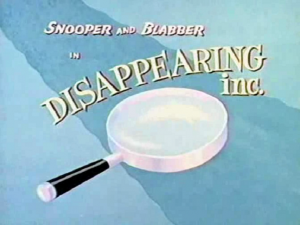 Disappearing, Inc., a Snooper and Blabber episode of the “Quick Draw McGraw” show, features some cloak-and-dagger escapades typical to the series, involving a Dishonest John look-alike (who prides himself upon meeting the description of being a villainous, unscrupulous criminal) hijacking a professor’s new invisibility formula (consisting of liquid ingredients A and B, which combined, form formula “ No Can C”) in the midst of a press conference. Adapting his invisibility powers to bank robbery, the villain makes an automobile getaway as an invisible driver packing a pistol as “heat”. Enter Detectives Snoop and Blab to the rescue. The crook hijacks the engine block out of their prowl car, prompting Blabber to make the obvious remark that “The motor’s missing.” Snooper replies, “Keep that up, and you’ll be missing.” An Irish traffic cop concludes he’s “not a well man”, after first seeing a driverless getaway car, followed by Snooper’s inquiry for the crook: “You’d know him if you saw him – cause you can’t see him.” After some routine invisible hide-and-seek, Snooper decides to tight fire with fire, and pours a bottle of the formula down Blabber’s throat. Blabber becomes an invisible accomplice, and as Snooper leaves a trail of dollar bills leading to an open bank vault (which the invisible villain follows with a street-cleaner’s bag and nail-on-a-pole to pick up the bills), Blabber slams the bank vault door closed, sealing the villain in the vault. Returning to the professor, Snooper discovers that his brainstorm has backfired, as we join them as Snooper discovers “There ain’t no formula to make me partner here visible?” The professor states that he’s working on it, and suggest they come back for same – in about ten years! Giving a whistle to Blabber to blow so that Snooper can keep track of him, Snooper complains to the audience for the curtain line that now he’s stuck with an assistant who has “no visible means of support.”
Disappearing, Inc., a Snooper and Blabber episode of the “Quick Draw McGraw” show, features some cloak-and-dagger escapades typical to the series, involving a Dishonest John look-alike (who prides himself upon meeting the description of being a villainous, unscrupulous criminal) hijacking a professor’s new invisibility formula (consisting of liquid ingredients A and B, which combined, form formula “ No Can C”) in the midst of a press conference. Adapting his invisibility powers to bank robbery, the villain makes an automobile getaway as an invisible driver packing a pistol as “heat”. Enter Detectives Snoop and Blab to the rescue. The crook hijacks the engine block out of their prowl car, prompting Blabber to make the obvious remark that “The motor’s missing.” Snooper replies, “Keep that up, and you’ll be missing.” An Irish traffic cop concludes he’s “not a well man”, after first seeing a driverless getaway car, followed by Snooper’s inquiry for the crook: “You’d know him if you saw him – cause you can’t see him.” After some routine invisible hide-and-seek, Snooper decides to tight fire with fire, and pours a bottle of the formula down Blabber’s throat. Blabber becomes an invisible accomplice, and as Snooper leaves a trail of dollar bills leading to an open bank vault (which the invisible villain follows with a street-cleaner’s bag and nail-on-a-pole to pick up the bills), Blabber slams the bank vault door closed, sealing the villain in the vault. Returning to the professor, Snooper discovers that his brainstorm has backfired, as we join them as Snooper discovers “There ain’t no formula to make me partner here visible?” The professor states that he’s working on it, and suggest they come back for same – in about ten years! Giving a whistle to Blabber to blow so that Snooper can keep track of him, Snooper complains to the audience for the curtain line that now he’s stuck with an assistant who has “no visible means of support.”
 Barney the Invisible (9/28/62), a 3rd season episode of The Flintstones, chronicles the coincidental happening of Barney developing a seemingly incurable case of the hiccups and Fred being on an “inventor” kick, attempting to develop in his garage a new soft drink to rock the world and set the predominant favorite drink, “Cactus Cooler” on its ear. Fred samples his 111th formula (which he christens “111 Up”) – and gags at how awful it tastes. Deciding some of the greatest inventions occur by accident, he pours all of his formulae together in one vat – 112 Up coming up! Barney happens by on his way to the doctor, and Fred gets him to sample the new concoction as a possible hiccup cure. It must be powerful stuff, as ingesting it causes not only Barney, but the clothes he’s wearing, to disappear. (But it does cure the hiccups, so Fred’s not a total failure.) After Fred makes some lame excuses to Wilma to cover up for hearing Barney’s voice in the garage (including “practicing ventriloquism”), Wilma sends Fred to follow along after Barney to see how he’s doing on his doctor’s visit (actually alerting the doctor on the phone to examine Fred too!). On their way out, Fred encounters Dino, who knocks him down for a slurping greeting, but gets spooked when he hears a bodyless Barney tell him to cut it out, and goes running for parts unknown. Fred tells invisible Barney that he’ll need to borrow Barney’s car, as Fred’s has a flat. (He must have hit quite a bump in the road, considering that Fred’s “tires” are stone cylinders!) Barney, not liking others to use his vehicle, insists on doing the driving. A local traffic cop, seeing Fred in the back seat of a driverless auto, rubs his stomach, and states “Those onion and pterodactyl sandwiches will do it every time.”
Barney the Invisible (9/28/62), a 3rd season episode of The Flintstones, chronicles the coincidental happening of Barney developing a seemingly incurable case of the hiccups and Fred being on an “inventor” kick, attempting to develop in his garage a new soft drink to rock the world and set the predominant favorite drink, “Cactus Cooler” on its ear. Fred samples his 111th formula (which he christens “111 Up”) – and gags at how awful it tastes. Deciding some of the greatest inventions occur by accident, he pours all of his formulae together in one vat – 112 Up coming up! Barney happens by on his way to the doctor, and Fred gets him to sample the new concoction as a possible hiccup cure. It must be powerful stuff, as ingesting it causes not only Barney, but the clothes he’s wearing, to disappear. (But it does cure the hiccups, so Fred’s not a total failure.) After Fred makes some lame excuses to Wilma to cover up for hearing Barney’s voice in the garage (including “practicing ventriloquism”), Wilma sends Fred to follow along after Barney to see how he’s doing on his doctor’s visit (actually alerting the doctor on the phone to examine Fred too!). On their way out, Fred encounters Dino, who knocks him down for a slurping greeting, but gets spooked when he hears a bodyless Barney tell him to cut it out, and goes running for parts unknown. Fred tells invisible Barney that he’ll need to borrow Barney’s car, as Fred’s has a flat. (He must have hit quite a bump in the road, considering that Fred’s “tires” are stone cylinders!) Barney, not liking others to use his vehicle, insists on doing the driving. A local traffic cop, seeing Fred in the back seat of a driverless auto, rubs his stomach, and states “Those onion and pterodactyl sandwiches will do it every time.”
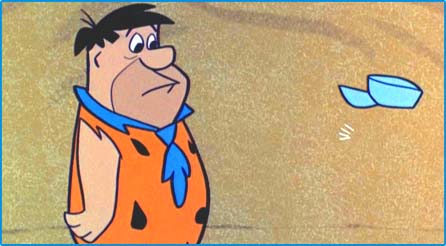
Fred suggests a side stop to watch a few games at the bowling alley while he tries to figure out some solution to Barney’s condition. Inside, they observe a newcomer to Bedrock, Loudmouth Sandstone, showing off his bowling prowess to spectators in the gallery. Fred tries to stay inconspicuous, commenting to Barney how this guy is his nemesis who he just can’t seem to win a game against – but Loudmouth spots him and publicly ridicules him to the crowd, by referring to having heard the flapping of wings, as a “pigeon” just flew in. Fred attempts to turn down Loudmouth’s challenge to a game, but Barney whispers that he could have the edge – with an invisible friend down near the pins. So a grudge match commences. Loudmouth seems to have no end of disappointments. A well placed ball suddenly deviates off course at a right angle by an invisible “kick”, crossing over into the next two alleys. A perfect strike disintegrates as the 7 and 10 pins miraculously regain standing position to form an impossible split. Loudmouth can’t even pick up one of the pins on his second shot, as it “hops” up and over the approaching ball. Another ball develops a mysterious reverse English – slowing to a stop just shy of the head pin, then reversing its rotation and rolling right back to its owner. Fred meanwhile can do no wrong. A wild shot that only hits the 7 pin knocks down the entire ten pins in a strike sideways. His final shot (delivered blindfolded), has him hike the ball through his legs like a football center, producing another 7-10 split – but the remaining pins develop delayed wobbles and each fall, giving Fred a perfect game – and Loudmouth a case of uncontrollable weeping.
Fred and Barney finally make it to a befuddled doctor – who on the strength of Wilma’s phone call presumes Fred is a nut when talking about his “invisible friend”, humoring Fred with the response “There’s a lot of it going around”, while hitting a buzzer for a burly attendant to drag Fred away. But Barney speaks up, and the doctor realizes there’s more here than meets the eye. He produces his own bottled concoction, which he comments was used to great effect as a cure on a late-night horror movie – but for Barney, nothing. Barney leaves disgusted, and Fred barely catches on to the tail end of Barney’s car as it roars apparently driverless down the street. Another cop braver than the first one pulls them over, and seeing no driver, gives a ticket to Fred. The two finally trudge their way home on foot – and the potion wears off just before they reach home, with Barney his old self again. Upon reaching home, Wilma informs Fred that Dino’s been hiding in the garage all afternoon. “The garage?”, reacts Fred, fearing the worst. He enters it and calls for Dino – and his worst suspicions are confirmed. Dino’s been into the 112 Up, and Fred is knocked to the ground by the standard slurping greeting of an invisible dinosaur. Wima and Betty ask what is going on, and Barney, laughing, states, “Let’s sit down, ladies. It’s a long story!”
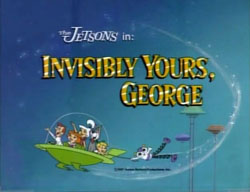 On the other hand. Invisibly Yours, George, a 10/27/87 episode in the revival of The Jetsons, lacks both the spark and the storytelling skill of the original network run. A young relative of Spacely labors in the new product development of Spacely Sprockets on a top secret spot remover, and George is recruited as the unwilling guinea pig for tryout of formula after formula. Unfortunately, his suits are taking a beating under deluges of spaghetti sauce, oil sludge, etc., which never come off. As Spacely and his protegé toss in the trash another cartload of the failed formulas, something finally happens to George on his way home. His clothes stay as they were, but he becomes invisible. As in the Flintstones’ episode, he makes an odd sight to the local traffic cop driving his space saucer with no head and no hands. At home, Astro, half-asleep, thinks he’s just a bad dream. Discovering his plight, George phones Spacely, who is delighted despite George’s panic at believing he’s stumbled upon a million space-bucks invention – until he is reminded that he threw the formula out. Some deduction discloses that Harlan, flunkey of Spacely’s rival Cogswell, has been raiding the Spacely trash dumpster for any discarded product Cogswell might make use of . George is ordered into an undercover role to infiltrate Cogswell’s plant and recover the stolen formula. From here on, the remainder of the script becomes highly routine, including standard invisible skulking, padded with an unlikely subplot about Jane rehearsing for a community play with a love sene that gets George and building superintendent Henry believing she might be up to hanky-panky, and George derelicting his duty after recovering the pilfered formula by apparently using up the remainder of the bottle to invisibly spy on Jane. Plot inconsistencies arise involving periodic reappearances of George, requiring him to respritz himself with formula at increasingly frequent intervals – what gets inconsistent is that in all bit one instance, George reappears in the manner of H.G. Wells’ Invisible man, lacking in clothing – yet in one reappearance at Cogswell’s plant, George reappears with his entire suit on, conveniently avoiding the nudity issue (I thought the invisibility wasn’t supposed to work on clothing!). Even the ending suffers from this obvious inconsistency, with George and Jane, reconciled, escaping from everybody and hiding in plain sight with their space car atop a building, and George spritzing both of them with presumably the last of the formula so that they can share a romantic moment together despite being out in public – but neither George nor Jane remove any clothes to accomplish this! C’mon, writers! I know you’ve got to accommodate the censors, but do it coherently!
On the other hand. Invisibly Yours, George, a 10/27/87 episode in the revival of The Jetsons, lacks both the spark and the storytelling skill of the original network run. A young relative of Spacely labors in the new product development of Spacely Sprockets on a top secret spot remover, and George is recruited as the unwilling guinea pig for tryout of formula after formula. Unfortunately, his suits are taking a beating under deluges of spaghetti sauce, oil sludge, etc., which never come off. As Spacely and his protegé toss in the trash another cartload of the failed formulas, something finally happens to George on his way home. His clothes stay as they were, but he becomes invisible. As in the Flintstones’ episode, he makes an odd sight to the local traffic cop driving his space saucer with no head and no hands. At home, Astro, half-asleep, thinks he’s just a bad dream. Discovering his plight, George phones Spacely, who is delighted despite George’s panic at believing he’s stumbled upon a million space-bucks invention – until he is reminded that he threw the formula out. Some deduction discloses that Harlan, flunkey of Spacely’s rival Cogswell, has been raiding the Spacely trash dumpster for any discarded product Cogswell might make use of . George is ordered into an undercover role to infiltrate Cogswell’s plant and recover the stolen formula. From here on, the remainder of the script becomes highly routine, including standard invisible skulking, padded with an unlikely subplot about Jane rehearsing for a community play with a love sene that gets George and building superintendent Henry believing she might be up to hanky-panky, and George derelicting his duty after recovering the pilfered formula by apparently using up the remainder of the bottle to invisibly spy on Jane. Plot inconsistencies arise involving periodic reappearances of George, requiring him to respritz himself with formula at increasingly frequent intervals – what gets inconsistent is that in all bit one instance, George reappears in the manner of H.G. Wells’ Invisible man, lacking in clothing – yet in one reappearance at Cogswell’s plant, George reappears with his entire suit on, conveniently avoiding the nudity issue (I thought the invisibility wasn’t supposed to work on clothing!). Even the ending suffers from this obvious inconsistency, with George and Jane, reconciled, escaping from everybody and hiding in plain sight with their space car atop a building, and George spritzing both of them with presumably the last of the formula so that they can share a romantic moment together despite being out in public – but neither George nor Jane remove any clothes to accomplish this! C’mon, writers! I know you’ve got to accommodate the censors, but do it coherently!
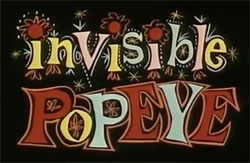 I formally decline to include a plot descriptive of Jack Kinney’s Invisible Popeye from the 1960’s King Features TV run. Whatever this far-out return of Popeye (this time with Olive) to outer space through Wottaschnozzle’s time machine may have begun as in the storyboard stage, it was entirely sabotaged by a nearly invisible budget, an utter lack of story continuity sense (leaving plot holes the size of black holes), and haphazard editing that appears to have settled on using only every fourth line of dialogue from any original script to cut for time, rendering the final product nearly nonsensical. In this state, I couldn’t begin a competent plot synopsis – as one would require rewriting the missing three-quarters of the film to provide any logical explanation for its events. Unless you are a fan of Ed Wood or other film genres that may be “so bad they’re laughable”, save your valuable time and avoid looking this one up on the net. It’s there, but you are forewarned.
I formally decline to include a plot descriptive of Jack Kinney’s Invisible Popeye from the 1960’s King Features TV run. Whatever this far-out return of Popeye (this time with Olive) to outer space through Wottaschnozzle’s time machine may have begun as in the storyboard stage, it was entirely sabotaged by a nearly invisible budget, an utter lack of story continuity sense (leaving plot holes the size of black holes), and haphazard editing that appears to have settled on using only every fourth line of dialogue from any original script to cut for time, rendering the final product nearly nonsensical. In this state, I couldn’t begin a competent plot synopsis – as one would require rewriting the missing three-quarters of the film to provide any logical explanation for its events. Unless you are a fan of Ed Wood or other film genres that may be “so bad they’re laughable”, save your valuable time and avoid looking this one up on the net. It’s there, but you are forewarned.
Two Beany and Cecil episodes from the 1960’s series (one unavailable for review from Internet sources), included the Invisible Man as a guest: Beany and Cecil Meet the Invisible Man, and The Invisible Man Has Butter Fingers. The former features only a small part for the character. Looking for a genuine home to raise Beany instead of the Leakin’ Lena, Captain Huffenpuff takes his crew to the “Edgar Allen Po’ House”, a haunted mansion up for sale. The owner is a caricature of Alfred Hitchcock’s silhouette (seen as a shadow only) from “Alfred Hitchcock Presents”. Inside the house’s “playroom” (including a rack, iron maiden, etc.), the Invisible Man (sen only by a hat, glasses, gloves and shoes) is manacled to a wall as a “permanent house guest”. While the owner and the Captain attempt to haggle out a sale, Beany and Cecil take in some local television (what the owner describes as the modern-day form of torture). A series of macabre hosts present ghoulish films and commercials, including a sales pitch for “Jekyll Juice”. The Invisible Man overhears it, spies such a bottle within reach, and swallows its contents. His gloved hands morph into clawed monster-mitts, and with new strength he breaks his chains. While a headache commercial airs, the Man’s monster claws tear Cecil’s cranium in two like it had a zipper down the middle, prompting Cecil to say, “Anyone got an aspirin?” He and Beany dash from the beast, picking up the Captain along the way before he can sign the deed. They roar away from the house so fast that the curving crooked road in front is stretched straight. The shadowy owner scolds Invisible at ruining another transaction, and takes the Invisible Man over his knee for a spanking, a red glow rising from the invisible air-space where his spanked rear-end should be. The second cartoon actually features even less of the Invisible Man, as he plays most of the film incognito in the form of an alter-ego, “Butterfingers”, a painted face on his gloved hand a la Senor Wences’ ventriloquist act. The plot (such as it is) involves Dishonest John trying to steal a reducing formula the Invisible Man has invented. A particularly gruesome gag provides its ending, where DJ is tricked into ingesting a massive dose of the formula (recollection is that normal dose was one drop – DJ wails, “I took the whole bottle!”) But he consoles himself, looking himself over, and believing that nothing happened – until he opens his coat, revealing nothing but a skeleton inside. To add insult to injury, a dog comes by and steals one of his bony legs, causing DJ to hop angrily after it to retrieve the pilfered limb. Gory stuff.
John Kricfalusi also tried the invisible bit in his short-lived The New Adventures of Beany and Cecil, with D.J.’s Disappearing Act Captain Huffenpuff has invented an invisible paint, which unfortunately wears off after a few minutes. Dishonest John steals it in hopes of using same for a diamond heist. Invisibility is handled in similar fashion to the late Wile E. Coyote episode referenced above, with characters and objects animated with dotted outlines. The plot has a few funny moments. In a nautical chase, DJ paints a suspension bridge invisible to have Cecil flatten himself in colliding with it. He then paints a whale invisible, causing the Leakin’ Lena to be swallowed by it – and encounter inside Pinocchio! DJ learns the drawbacks of invisibility when he tries the simple task of crossing a city street – and gets repeatedly run down by motorists, and even a passing parade, all of whom can’t see him. DJ’s paint keeps wearing off at inopportune times, resulting in an embarrassing encounter with burly museum guards whom DJ taunts in the belief he can’t be seen, but while actually in full view. DJ uses a museum dinosaur skeleton as a robotic weapon by installing lever controls on its back, wise-cracking to the audience, “Fred Flintstone, eat your heart out!” And an irate populace joins in the battle when DJ becomes visible with the stolen diamond, engaging in a free-for-all brawl with DJ outside the museum. Captain Huffenpuff, emerging from the museum, asks Cecil, “What’s that?” Cecil replies “The biggest fight cloud in the history of Saturday morning cartoons!”
Felix the Cat television episodes are often hard to trace – as they were originally released with only episode numbers and no titles. All titles currently assigned to them were invented after-the-fact, and often don=t tell exactly what the episode=s content is about. I remember an early one where the Professor would push a button on his chest and turn invisible – but can=t seem to find it anymore on the web. One that is still present has been retitled The Invisible Professor (Joe Oriolo, 1960), and deals with a scheme for the Professor and Rock Bottom to rob a small kingdom=s royal palace by using the Professor’s invisible paint. First, paint the two culprits invisible. Then, paint the object you want to steal invisible. Then walk out with the item right under everyone=s noses. Detective Felix is assigned to the case, and while sitting in the doorway of a large safe that=s just been emptied, discovers his backside and one finger have disappeared – and finds it=s invisible paint that rubs off. Having learned the method of the crime, the episode leaves entirely unclear how Felix somehow follows clues that should be invisible to the Professor’s hideout. There, a second invention – a spray gun of paint remover, restores the Professor and Rock to view, along with tons of gold and riches. Felix attempts to make an arrest, but Rock slams down a red rubber glove over Felix’s head, popping a hole for Felix’s face but leaving the rest of him bound like a straight jacket. Rock and the Professor set off to gather another load – but Felix escapes by connecting the bottom end of the glove to the exhaust end of a vacuum cleaner, blowing the glove up like a balloon and popping it. Taking the paint remover gun with him, he paints himself invisible. At the palace, amidst another crime spree, Felix sprays a dose of paint remover into the room, revealing Rock and a wheelbarrow of loot, who comments “This is embarrassing”. The invisible professor grabs a sword from the wall, and duels the invisible Felix, who uses the spray gun as his weapon. The professor lunges – and gets the point of his sword caught in an electric socket, with Felix spraying him visible, lighting up in pain. He and Rock make a run for freedom – but are carried back into the palace by an invisible force, which turns out to be a palace guard Felix has also painted invisible. Another two invisible guards are sprayed visible, carrying between them the first batch of loot recovered from the Professor’s hideout – and all is well, except for the Professor’s unintelligible muttering and Rock’s “What’s the use?”
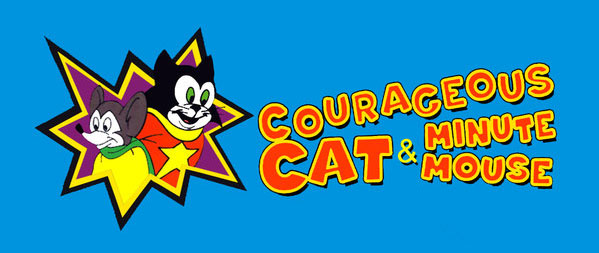
As with most episodes of Courageous Cat and Minute Mouse (a Sam Singer series in which his name itself has mysteriously disappeared out of most of the credits over the years), The Case Of the Invisible Robbers (1960?) is almost a total waste of time. Its thin plot line is basically a ripoff of Snooper and Blabber’s Disappearing, Inc., with only the changes that in this one, the professor=s invisibility formula is carbonated like soda pop. And that Courageous, as usual, has a setting on his all-purpose cat gun to restore visibility of the culprits. (Where=d it get this power, considering the professor just invented the invisibility potion?) By the way, did anyone ever notice that Courageous Cat’s theme music sounds a lot like Peter Gunn played upside down?
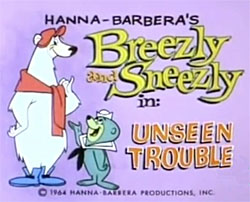 Unseen Trouble is an episode of Breezly and Sneezly – Hanna-Barbera’s closest effort to recloning Yogi Bear – as a white polar bear with a sneezing seal for a sidekick instead of Boo Boo and an army colonel (Colonel Fuzzby) in place of Ranger Smith. The studio had trouble maintaining an audience for it, and, in order to boost the ratings of the Peter Potamus show, which was lagging behind its stablemate, Magilla Gorilla, shifted the Breezly cartoons as the weakest link from Potamus into the Magilla half hour, replacing his spot with the more popular Ricochet Rabbit series from the Magilla show. (It would be several years before such ratings cross-pollenation would occur for the studio again – in moves such as turning the Cattenooga Cats show over to Motormouse and Autocat, splitting half of the C.B. Bears hour into Heyyy, It’s the King, and having Tom and Jerry adopt Grape Ape.)
Unseen Trouble is an episode of Breezly and Sneezly – Hanna-Barbera’s closest effort to recloning Yogi Bear – as a white polar bear with a sneezing seal for a sidekick instead of Boo Boo and an army colonel (Colonel Fuzzby) in place of Ranger Smith. The studio had trouble maintaining an audience for it, and, in order to boost the ratings of the Peter Potamus show, which was lagging behind its stablemate, Magilla Gorilla, shifted the Breezly cartoons as the weakest link from Potamus into the Magilla half hour, replacing his spot with the more popular Ricochet Rabbit series from the Magilla show. (It would be several years before such ratings cross-pollenation would occur for the studio again – in moves such as turning the Cattenooga Cats show over to Motormouse and Autocat, splitting half of the C.B. Bears hour into Heyyy, It’s the King, and having Tom and Jerry adopt Grape Ape.)
While Yogi sometimes strived to get out of Jellystone, Breezly’s constant passion was to get into Camp Frostbite – either for free handouts or just to carouse and have a good time. On one of such usual invasions, he is mistaken by a visiting scientist for a volunteer for an experiment, and placed in a glass chamber with electrodes. A pull of a switch – and Breezly=s invisible, except for his hat and scarf. The scientist celebrates at having created the ultimate secret weapon – an invisible soldier. Breezly catches on when he spots his cap and neckpiece floating in mid air in a mirror – without him under it. Handing his garments to Sneezly (who comments on first not-seeing him that he’s lost a lot of weight), Breezly decides to use his power to bug meddlesome Colonel Fuzzby – playing invisible ghost tricks to drive the Colonel crazy. But as the Colonel runs for cover while a cannon shell floats through the air self-propelled in pursuit of him, Breezly materializes under the shell, and the scientist lets the Colonel in on the experiment. Breezly runs for the experimental chamber to get invisible again, but the Colonel follows him inside. With a puff of smoke, both vanish from view – save for a double trail of footprints, and their voices shouting at each other as they carry the pursuit over the snow-covered hills.
 Secret Squirrel’s Ship of Spies (Hanna-Barbera, 1966), contains invisibility as a short plot point, with an invisible spy ship rumored to be in the harbor captained by rival enemy agent Hi-Spy. Secret and Morocco Mole of course find the invisible ship by crashing their flying car into it. (Couldn’t they have just flown above and spotted a crater in the water, like Donald=s silhouette in The Vanishing Private?) A few interesting shots have them scaling the hull but appearing to climb on thin air, and walking an invisible deck – with Morocco falling into an invisible open hatch. But as with Courageous Cat, Secret’s got a gadget for every occasion – including a spray to make the ship visible again. The rest of the film is the usual game of gadgetry one-upsmanship between Secret and the Spy, with Secret finally pulling a plug and accidentally sinking the ship. The three wind up marooned on a desert island, with Hi-Spy chasing our heroes round and round the island in an endless circle.
Secret Squirrel’s Ship of Spies (Hanna-Barbera, 1966), contains invisibility as a short plot point, with an invisible spy ship rumored to be in the harbor captained by rival enemy agent Hi-Spy. Secret and Morocco Mole of course find the invisible ship by crashing their flying car into it. (Couldn’t they have just flown above and spotted a crater in the water, like Donald=s silhouette in The Vanishing Private?) A few interesting shots have them scaling the hull but appearing to climb on thin air, and walking an invisible deck – with Morocco falling into an invisible open hatch. But as with Courageous Cat, Secret’s got a gadget for every occasion – including a spray to make the ship visible again. The rest of the film is the usual game of gadgetry one-upsmanship between Secret and the Spy, with Secret finally pulling a plug and accidentally sinking the ship. The three wind up marooned on a desert island, with Hi-Spy chasing our heroes round and round the island in an endless circle.
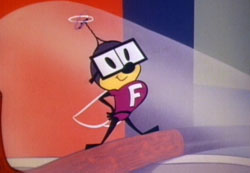 Invincible vs. Invisible is an episode of Fearless Fly from the 1965-67 Milton the Monster Show produced by Hal Seeger, on which veteran Paramount animator Myron Waldman worked. It is rather routine, with series villains, the Oriental menace Dr. Goo Fee and his stooge Gung Ho preparing for the Doctor=s birthday, by arranging for rare treasures to be stolen to serve as his presents, again by use of invisible paint upon Gung Ho. In a plot point entirely inconsistent with repeated stock footage used in each episode=s opening (which declares that no fly swatter can hurt Fearless Fly), Goo Fee and Gung Ho arrange a secret weapon of a fly swatter painted invisible. Not seeing it coming, Fearless is struck – and almost appears to be done for. But he of course comes to, and, as Dr. Goo Fee=s mountain palace is in the snow-capped peaks of Tibet, Fearless opens a skylight above Gung Ho’s head, dumping a load of snow upon him which makes him and the fly swatter visible. Dr. Goo Fee surrenders the treasures – and even offers Fearless a piece of his birthday cake. Back home, as his humble alter ego Hyram Fly, Hyram listens as usual to the bragging of a neighborhood dragonfly rival – but his rival=s gabbing is broken up by a whooshing sound behind him that sends him jumping, and thinking the place must be haunted. Hyram lets us in on cause: I thought this invisible fly swatter would be fun!
Invincible vs. Invisible is an episode of Fearless Fly from the 1965-67 Milton the Monster Show produced by Hal Seeger, on which veteran Paramount animator Myron Waldman worked. It is rather routine, with series villains, the Oriental menace Dr. Goo Fee and his stooge Gung Ho preparing for the Doctor=s birthday, by arranging for rare treasures to be stolen to serve as his presents, again by use of invisible paint upon Gung Ho. In a plot point entirely inconsistent with repeated stock footage used in each episode=s opening (which declares that no fly swatter can hurt Fearless Fly), Goo Fee and Gung Ho arrange a secret weapon of a fly swatter painted invisible. Not seeing it coming, Fearless is struck – and almost appears to be done for. But he of course comes to, and, as Dr. Goo Fee=s mountain palace is in the snow-capped peaks of Tibet, Fearless opens a skylight above Gung Ho’s head, dumping a load of snow upon him which makes him and the fly swatter visible. Dr. Goo Fee surrenders the treasures – and even offers Fearless a piece of his birthday cake. Back home, as his humble alter ego Hyram Fly, Hyram listens as usual to the bragging of a neighborhood dragonfly rival – but his rival=s gabbing is broken up by a whooshing sound behind him that sends him jumping, and thinking the place must be haunted. Hyram lets us in on cause: I thought this invisible fly swatter would be fun!
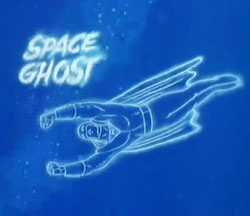 I’m not that much of a cartoon superhero fan – and thus not properly qualified to cover the many supervillains, and possibly a few superheroes, who could attain invisibility, so I’ll bow out on such a discussion. And don’t get me started on Wonder Woman’s invisible plane!
I’m not that much of a cartoon superhero fan – and thus not properly qualified to cover the many supervillains, and possibly a few superheroes, who could attain invisibility, so I’ll bow out on such a discussion. And don’t get me started on Wonder Woman’s invisible plane!
Invisible men have remained viable animation vehicles down to the present day. The computer-animated series of features commencing with Sony’s Hotel Transylvania retains an invisible man as a regular part of the monsters’ rogues-gallery. And a French-based unit of Disney television animation, in a joint production with other European studios, has apparently produced a 26 episode animated series, The Invisible Man (2005), which seems to have only been aired abroad, though episodes in English exist and are currently viewable free on the Internet. These feature a youthful invisible man who plays it as a hero, using his powers to thwart crime. Based on only a preliminary view of about half an episode (which are on the long side, averaging 26 minutes, obviously intended for non-commercial networks and thus posing a problem for American syndication where heavy editing-for-time would be required), the production values seem competent – but it feels like the lead character lacks compelling charisma to put the series over, possibly accounting for the lack of interest from American networks. Judge for yourself if you choose, and anyone with more detailed information upon characters and quirks of this series is welcomed to contribute comments below.
For now, I’m going to turn invisible, too – – – until next week.


 Charles Gardner is an animation enthusiast who toils by day as a member of LA Law – but by nights and weekends indulges in classic jazz and ragtime as a performer; and studies classic Hollywood cartoons… maybe a little too much.
Charles Gardner is an animation enthusiast who toils by day as a member of LA Law – but by nights and weekends indulges in classic jazz and ragtime as a performer; and studies classic Hollywood cartoons… maybe a little too much.


































































































































































An additional footnote: Missing from the above was Yogi Bear’s “Bear For Punishment” (11/20/59) – With the help of tourist Presto the Magician, Yogi and Boo Boo are turned invisible for a free-for-all raid on the picnic grounds. Ranger Smith would blame Yogi for the rampant basket disappearances, but he hasn’t even seen Yogi all day. But Yogi overplays his advantage, insisting on one more basket for the road, leaving Presto waiting impatiently. Long-distance, Presto, preparing to leave, reverses the spell. The bears become visible – just as Ranger Smith comes face to face with the red-handed Yogi. Thinking he’s still invisible, Yogi silently taunts the ranger by making faces at him. That’s the limit, and Ranger Smith socks Yogi for a lights out. Yogi awakens in a jail cell, and bemoans his fate. “How lucky can you get? One swing, and he hits an invisible bear!”
“We do not need more of the things that are seen. We need more of the things that are unseen.” — “Silent Cal” Coolidge, 1921
This week’s collection runs the gamut from bona fide classics to mind-numbing curiosities. Now that I’ve seen “Invisible Popeye”, I wish I could un-see it.
Fred Flintstone’s rival in “Invisible Barney” is actually named Blow Hard Sandstone, not “Loudmouth”. It’s printed that way, as two words, on the bowling score sheet, and presumably on his birth certificate as well.
In the Hanna-Barbera cartoons, the invisible character’s location is indicated by radiating lines animated synchronously with the dialogue. This device was used to better effect for the disembodied voice in Avery’s tour-de-force “Ventriloquist Cat” (1950).
I always wondered if Space Ghost ever used his Inviso-Power to spy on Jan in the shower.
Un-see you later!
“The Foghorn Blows at Midnight” is one of my favorite Foghorn cartoons (after the invisible cream bit, my favorite scene is Foggy pretending to beg for his life), but it’s not the only one to subvert the invisible cream gag. One of McKimson’s Honeymousers shorts, which spoof The Honeymooners, has Ralph paint Norton with invisible ink as a joke, pretending that he’s invisible so he can get food past the cat. Norton only gets away with it because the cat is dumbfounded at his cavalier attitude, so when Ralph tries it, the cat is onto them and clobbers him.
A more recent TV cartoon about invisibility is the SpongeBob SquarePants episode “Pranks a Lot”, where SpongeBob and Patrick buy a can of invisible spray paint, and after making themselves invisible with it, decide to prank everyone into thinking they are ghosts. Also of note from the same show is Mermaid Man and Barnacle Boy’s invisible boatmobile, which they always have trouble finding. (“I told you making the boatmobile invisible was a bad idea!”)
Another 1959-60 Felix about iunvisibly was called Tank GUn (due to a tank near the end ) and has The Professor wearing a belt that can render him invisible (I guess The Invisible Professor II wasn’t a good title). He then uses this ti chase after Flix and his famous magic bag of tricks, with his gloves as a giveaway. He chases Felix into a manhole with the cover off,while Felix’s still on the street. Felix then lifts the manhole cover, puts itr back on The Professor, then slams it on him without knowing..a lump grows as the scientist gets out of the hole., He then later spies Feliz and the bag asleep with the window open I(remember when it actuallt was SAFE to do thjat, no screen?), steals the bag and the first p[art’s over. BUt then second part Felixz frees himselkf and chases the Professor, who goes in his lab, renders THAT invisible, and tries THAT to confuse Felix, who then catches on. Once visible the two resume the hadse..Felix turns the bag into a tank (thus the current title) and gets ther bag bnack from the Professor, slides out then..Profesasor;”And you can give it right back”, but Felix gets the bag back, then turnms it into a hawk, during aniter chase from the mad doc, nand the hawk grabns the belt with the invisiblity gadet, sothe Prof.crashes into his lab, leaving it in pieces till the next cartoon.
Thanks. Knew I’d seen it, but couldn’t figure out the arbitrary title.
Wasn’t there a Punkin’ Puss & Mushmouse episode, involving invisibility?
Good catch. Episode is not available online. It was called, “Seein’ is Believin'”.
A couple of comparably recent Nickelodeon TV shorts, The Fairly OddParents episode “Timvisible” (2002) and the SpongeBob SquarePants episode “Pranks a Lot” (2004), also have invisibility as a main plot point. In both cartoons, the main character(s), Timmy Turner in the former, SpongeBob and Patrick in the latter, become invisible; Timmy through a magic spell and SpongeBob and Patrick through a can of “invisible spray” from a novelty shop. In both cartoons, the characters pretend to be ghosts as a practical joke and cause mass panic.
The Peanuts special “It’s Magic, Charlie Brown” has Snoopy putting on a magic show, ending with him making Charlie Brown disappear, but the show gets rained out, leaving Charlie Brown invisible. He bemoans that he’s now a “lost soul”, but then uses his invisibility to finally kick Lucy’s football. Eventually, Snoopy manages to turn him back to normal, just as he’s about to kick the football again.
Nice one. I’d forgotten this special, as it wasn’t included in the multi-episode Peanuts compilations on dvd. I see it was only issued on a re-release of “Great Pumpkin” as a bonus extra. Much “toonier” than the average Peanuts episode. I’m going to have to get a copy for my library!
Somewhat surprisingly for a cartoon centered around magic, there is very little invisibility in Winx Club. In the Season 2 episode “The Invisible Pixies” (that’s the RAI English title; it’s “Gangs of Gardenia” in 4Kids, and “La Dama del Ballo” in the original Italian), said pixies do not have the power to make themselves invisible; they simply cannot be seen by non-magical beings — in this case, adults on Earth. (Children, who have not yet lost the magic they were born with, can see them clearly.) When Musa and Aisha (Layla) need to be rescued from a dance club filled with dangerous characters, Stella asks: “You know an invisibility spell, Bloom?” “I don’t,” is Bloom’s reply. One infers that such spells are a form of subterfuge that violates the fairy ethos.
So it comes as no surprise that the only invisibility spell in the series is cast, not by the Winx, but by the Trix (i.e., the witches Icy, Darcy and Stormy). At the beginning of the Season 5 stand-alone Christmas episode “A Magix Christmas”, the Trix are spying on the Winx at the Alfea School for Fairies as Bloom tells her friends about Christmas; and, misinterpreting the phrase “Christmas magic” as some new power, the witches resolve to wrest it from her. They come to Alfea and use an invisibility spell to move about undetected; we can see them, but we know they’re invisible because they’re transparent and have a pink glow. “I never get tired of being invisible!” Stormy declares as she cruelly knocks over a hapless fairy. The Trix summon ice dragons to attack the school, and later create an ice barrier around it, but ultimately disclose their presence with their incessant fiendish cackling.
Despite having an invisibility spell in their magical repertoire, the Trix never use it again. It certainly would have been useful for doing Tritannus’s dirty work during the course of Season 5. Maybe Stormy got tired of it after all.
I hope to see Big Game Haunt (Warner, 2/10/68, Alex Lovy – Dir.) Starring Cool Cat, Colonel Rimfire and Spooky from the Seven Arts era (1967-1969) is on Halloween Cartoon post on the future Animation Trail post on Cartoon Research on October 30th? Please Charles Gardner, choose Big Game Haunt (Warner, 2/10/68, Alex Lovy – Dir.) and post on Halloween Cartoon post on the future Animation Trail post on Cartoon Research on October 30th, 2019?
I don’t want to leave out here the “Rugrats” episode, “The Baby Vanishes” (just in case Cheryl is reading this). In this one, after Angelica is caught (but quickly forgiven) using her mother’s make-up, she learns about vanishing cream (which doesn’t really work on wrinkles but grown-ups pretend it works for their sakes). This gives Angelica an idea for a dirty trick later that day when her dad, Drew, takes her to their relatives house where the adults are playing a strategy board game. Angelica gives Tommy and Chuckie the idea of going to Didi’s room and use her vanishing cream so they can steal some chocolate cake that Drew brought from home. After both babies put a dab of it on, Angelica pretend that the two are really invisible and they go out to the kitchen to get the cake. Since the grown-ups are so involved with the board game, they don’t notice Tommy and Chuckie behind them taking the chocolate cake and going back to the pen. Angelica, expecting the babies to get in trouble, is surprised they got the cake and is now convinced that the vanishing cream really works and only grown-ups don’t see them. She has the babies to help her complete cover her (and Cynthia) with the cream thinking she can do whatever she wants without getting caught.
Meanwhile, after doing a magazine quiz, Drew realized that he raises Angelica as a spoil brat and is ashamed of it. Didi suggests the Lipshchitz method of psychology by completely ignoring her bad behavior. Drew accepts doing the method. When the completely cosmetically covered Angelica comes in the kitchen doing her tricks on the grown-ups, they pretend she isn’t there . Drew, however, has a hard time ignoring his daughter’s shenanigans while keeping his cool especially when Angelica fatteningly says out-loud that she threwout some big office plans out the car in the freeway after being made to eat broccoli.
After going back to the pen , Angelica thinks it’s fun being invisible until Didi comes out and give all the kids but Angelica cookies and still pretending Angelica isn’t there (thinking her niece took the pie). Angelica then decides being “invisible” isn’t so fun and panics when she can’t get the cream off.
Drew, just about had it for Angelica actions decides to punish his daughter only to hear Angelica saying she loves him and crying that she’s going to be “inviable” forever. Drew realizes that she learned her lesson and decide to take her home to get cleaned-up and get ice cream after that. She gladly accepts.
I don’t get something in the episode
Invisibility also plays a part in “Gem Dandy” (Roland and Rattfink), “Here, There, Skeletors Everywhere” (He-Man) for a couple of gags and is the drving plot behind “Dr. Von Goosewing’s Invisible Ray” (Count Duckula). There’s also a very brief invisible gag in “Tower of Terror” (Danger Mouse)
Just a minor correction, “Clippity Clobbered” was actually produced by Format Films/Format Productions, not DePatie-Freleng, although DePatie-Freleng did subcontracted this cartoon and 13 other WB cartoons to Format (Rudy Larriva’s 11 Wile E. Coyote and Road Runner cartoons and 3 Daffy and Speedy cartoons).
Here’s another late find: “Lab Grab” from the 1960’s “Dick Tracy” show from UPA. Joe Jitsu investigates a laboratory break-in where the Brow and Oodles hope to replicate an invisibility formula from a scientist’s notebook. Joe enters and pretends to help Oodles find the page with the formula, while mixing a batch for himself. Joe drinks the whole dose, and becomes invisible just in time to dodge a thrown knife. He delivers some judo throws to Brow, then while the crooks are confused, switches the notebook for another volume titled “101 Chemical Failures”. He lets the crooks grab the phoney notebook, and mix their own formula, resulting in internal explosions and disintegration of the crooks to powder. Joe adds water to the powder and brings them back as “instant crooks”. He then agrees to mix one more real batch of formula with “no tricks” – except Brow and Oodles each vie to down half of the dose, resulting in only invisibility of Brow’s upper half and Oodles’ lower half. Tracy arrives to cuff the culprits, as Joe’s dosage wears off. Joe suggests the formula could reap big savings for the state, as only one striped suit is needed to cover what’s left of the two criminals.